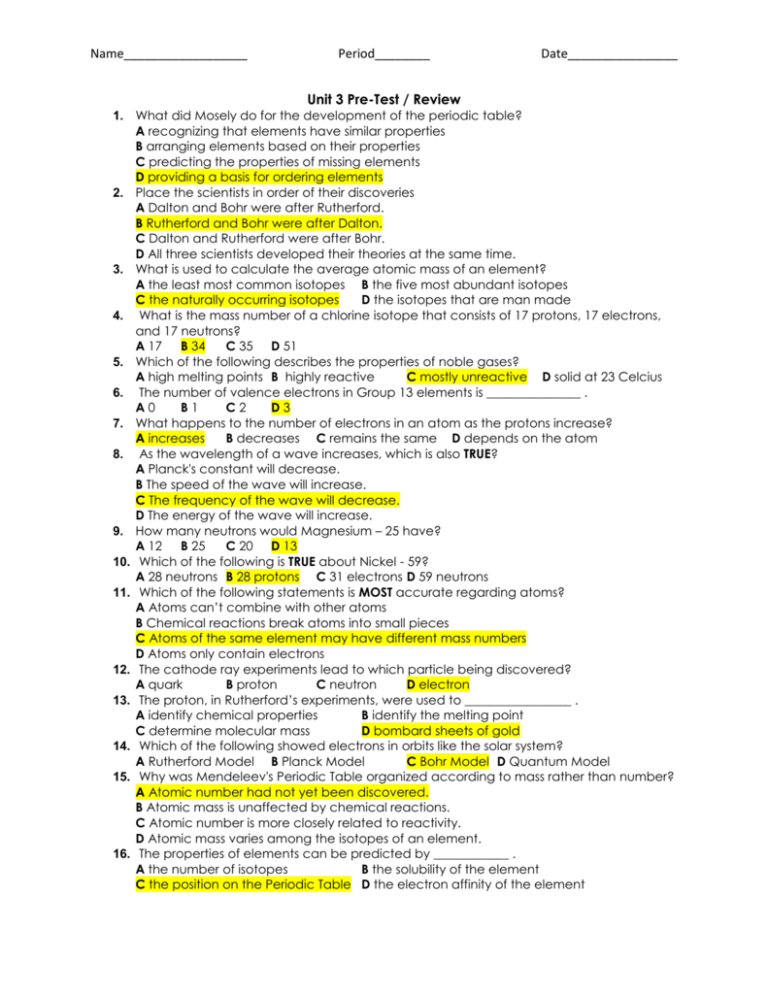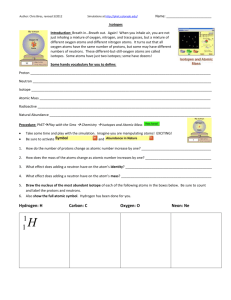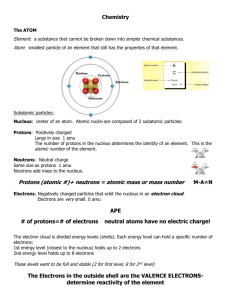Link to PreTest Key
advertisement

Name__________________ Period________ Date________________ Unit 3 Pre-Test / Review 1. What did Mosely do for the development of the periodic table? A recognizing that elements have similar properties B arranging elements based on their properties C predicting the properties of missing elements D providing a basis for ordering elements 2. Place the scientists in order of their discoveries A Dalton and Bohr were after Rutherford. B Rutherford and Bohr were after Dalton. C Dalton and Rutherford were after Bohr. D All three scientists developed their theories at the same time. 3. What is used to calculate the average atomic mass of an element? A the least most common isotopes B the five most abundant isotopes C the naturally occurring isotopes D the isotopes that are man made 4. What is the mass number of a chlorine isotope that consists of 17 protons, 17 electrons, and 17 neutrons? A 17 B 34 C 35 D 51 5. Which of the following describes the properties of noble gases? A high melting points B highly reactive C mostly unreactive D solid at 23 Celcius 6. The number of valence electrons in Group 13 elements is _______________ . A0 B1 C2 D3 7. What happens to the number of electrons in an atom as the protons increase? A increases B decreases C remains the same D depends on the atom 8. As the wavelength of a wave increases, which is also TRUE? A Planck's constant will decrease. B The speed of the wave will increase. C The frequency of the wave will decrease. D The energy of the wave will increase. 9. How many neutrons would Magnesium – 25 have? A 12 B 25 C 20 D 13 10. Which of the following is TRUE about Nickel - 59? A 28 neutrons B 28 protons C 31 electrons D 59 neutrons 11. Which of the following statements is MOST accurate regarding atoms? A Atoms can’t combine with other atoms B Chemical reactions break atoms into small pieces C Atoms of the same element may have different mass numbers D Atoms only contain electrons 12. The cathode ray experiments lead to which particle being discovered? A quark B proton C neutron D electron 13. The proton, in Rutherford’s experiments, were used to _________________ . A identify chemical properties B identify the melting point C determine molecular mass D bombard sheets of gold 14. Which of the following showed electrons in orbits like the solar system? A Rutherford Model B Planck Model C Bohr Model D Quantum Model 15. Why was Mendeleev's Periodic Table organized according to mass rather than number? A Atomic number had not yet been discovered. B Atomic mass is unaffected by chemical reactions. C Atomic number is more closely related to reactivity. D Atomic mass varies among the isotopes of an element. 16. The properties of elements can be predicted by ____________ . A the number of isotopes B the solubility of the element C the position on the Periodic Table D the electron affinity of the element N 17. What family name is given to Group 2 elements? A transition metals B alkaline series C lanthanide elements D actinide series 18. As the atomic number increases, within a group of elements, the atomic radius usually A decreases B remains the same as the one above it C increases D decreases, then increases 19. When is an atom considered electrically neutral? A neutrons equal protons B proton forces pull on the neutrons C electrons equal protons D electrons equal neutrons 20. What is an isotope? A different chemical properties B different numbers of protons C different masses D different numbers of electrons 21. Using the Periodic Table, predict which elements will have similar properties or reactivity. A nitrogen, sulfur and bromine B magnesium, strontium and barium C rubidium, yttrium and zirconium D cadmium, calcium and carbon 22. Based on information from the Periodic Table, which two elements will bond in ratio similar to that of potassium sulfide? (2:1) A magnesium and sulfur B lithium and oxygen C sodium and fluorine D magnesium and oxygen 23. Put the types of electromagnetic radiation in order from least to most energetic. A ultraviolet, visible, infrared, microwave B ultraviolet, visible violet, visible red, infrared C infrared, microwave, ultraviolet, xrays D radio, microwave, ultraviolet, gamma 24. When bombarded with light, strontium emits a light whose frequency is 3.84 x 1014 Hz. Given all electromagnetic radiation travels at the same speed (c = 3.00 x 10 8 m/s), calculate the wavelength and predict the color of the light. A blue B green C yellow D red 25. One of the wavelengths of light emitted by hydrogen atoms is 656 nm. Calculate the frequency. A 4.57 x 1014 Hz B 4.57 x 106 Hz C 1.97 x 1014 Hz D 1.97 x 106 Hz 26. A red spectral emission of cesium occurs at 671 nm. Given the speed of light and Planck’s constant (6.63 X 1034 Js), calculate the energy of one photon of this light. A 1.33 x 1018 J B 1.48 x 1018 J C 2.96 x 1019 J D 4.47 x 10 19 J 27. What physical property do Group 18 elements have in common that allowed scientists to make assumptions about their structure, and also led to their inclusion and specific placement on the modern Periodic Table. A conductivity B ionization energy C atomic radii D state at room temperature 28. A sample of Element X is contains 72.15% of the isotope type 1 (84.9118 amu) and 27.85% of isotope type 2 (86.9092 amu). Calculate the average atomic mass. A 85.13 amu B 85.47 amu C 86.21 amu D 86.49 amu 29. How many electrons are in an Ag+ ion? A 112 B 51 C 46 D 45 30. An isotope of mercury has 80 protons and 120 neutrons. What is the mass number of this isotope? A 200 B 120 C 80 D 201 31. Which of the following atoms would have the largest ionic radius? A lithium B sodium C potassium D rubidium 32. Which of the following atoms would have the HIGHEST ionization energy? A sodium B aluminium C sulfur D chlorine 33. Which of the following atoms would have the HIGHEST electronegativity? A sodium B chlorine C aluminium D sulfur ON







